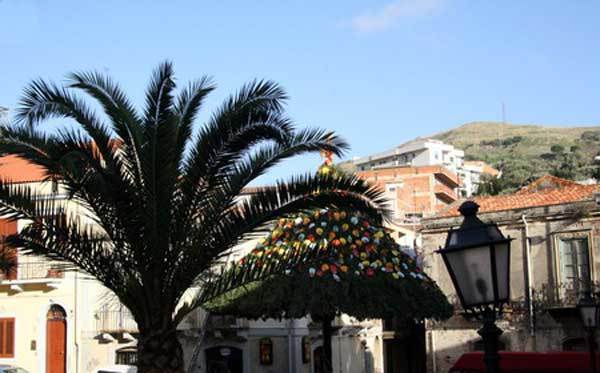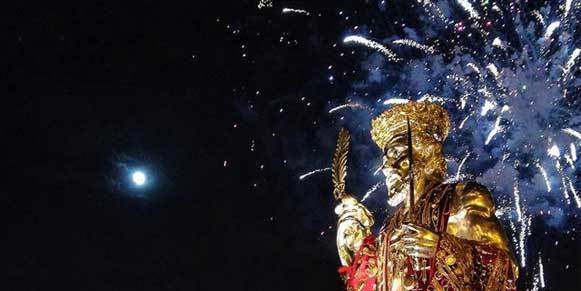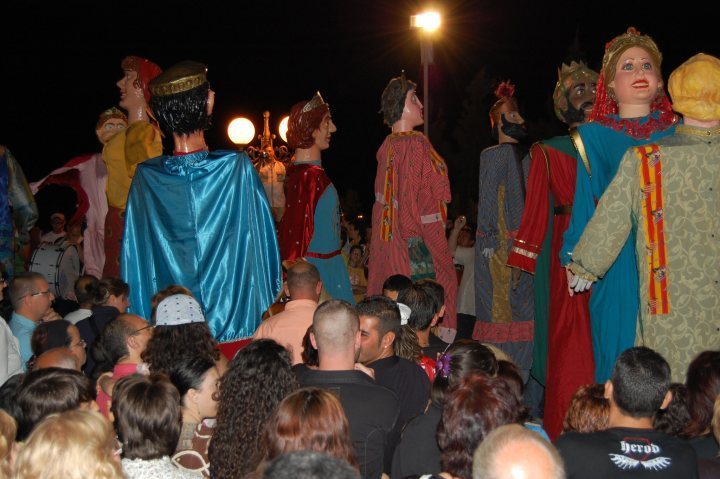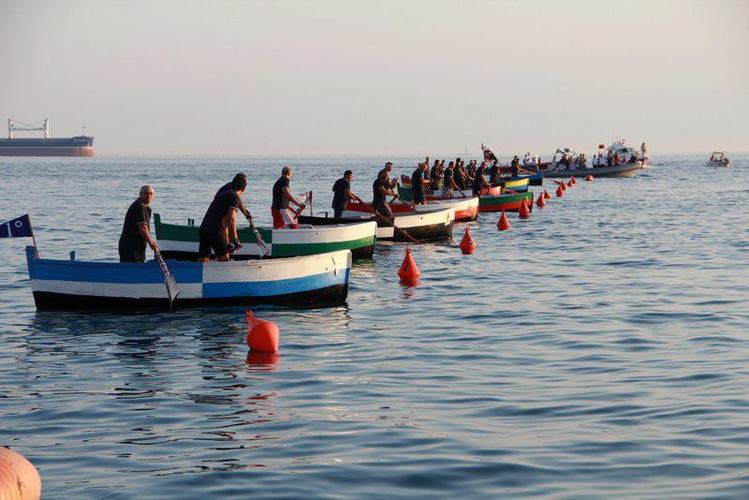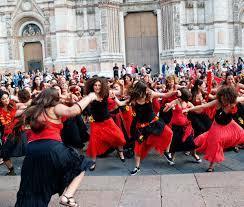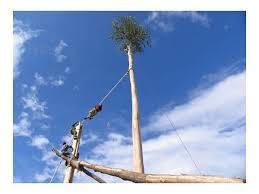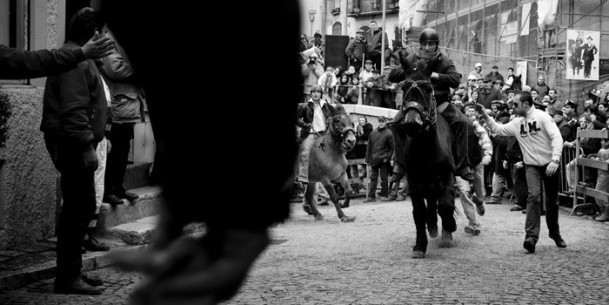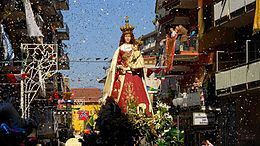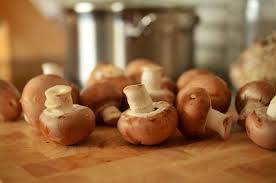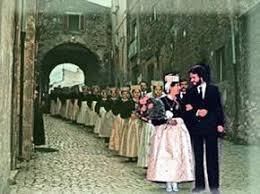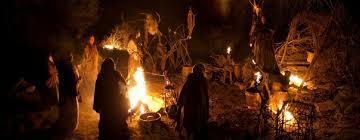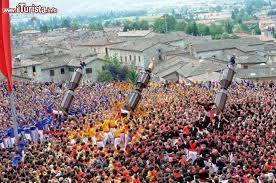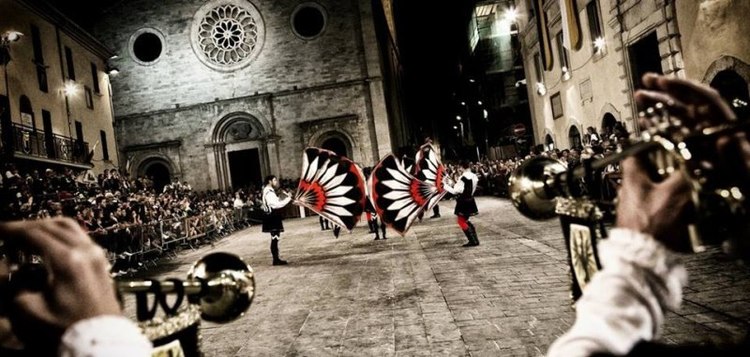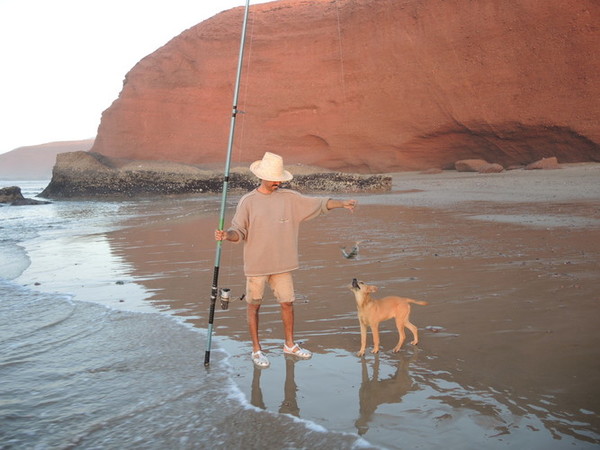Sicily
"Epiphany of Bordonaro":
The central square of Bordonaro, a small fraction of Messina, becomes the scene of an interesting event, known as U Pagghiaru, during which several young people challenge each other in an attempt to climb a sort of hut suspended on a high pole and decorated with various multicolored objects. The structure is decorated with oranges, lemons, cotton wool, colored cardboard rounds and unleavened bread donuts, while at its top a cross is planted, as it was used to be done in all pagghiara, the latter decorated with oranges, sausage, sandwiches that form a shining star and a long red ribbon. The whole represents a propitiatory rite to remove good from evil.

"The cord dance ":
It is the re-enactment of ancient peasant traditions, of pre-Christian origin. The twelve couples of dancers, symbolizing the months of the year, dance around a pole surrounded by ears of corn holding ribbons of various colors, which are intertwined to symbolize the seasons or the constellations that revolve around the sun, author of the rural fertility and of life. The dance is a tribute to the young spouses that their union is fruitful for children, well-being and joy. The bride wears a precious silver-gray dress with embroidery and lace from the eighteenth century and is wrapped in an ivory-white coat. In his hand he carries "Conocchia and Rosario", symbols of industriousness and conjugal faith. The groom wears a magnificent velvet suit with light blue jacket. Since ancient times this dance has been done to honor the gods of the woods or to celebrate other divinities in seasonal festivals with propitiatory rites and thanksgiving. Before the beginning of the Ball, in a tone of prayer, all the dancers and the oldest of the group, the "Pater Familias", recite a prayer of thanks to Jesus, because with the Mother, he propitiated the abundant collection of ears, rich in many particularly large and thick grains.

"Tormina art":
The Taormina Arte takes place in one of the greatest treasures of Greek architecture that has reached us. The Taormina Arte is divided into three sections Cinema, Theater, Music And Dance which offer world premiere shows. Opera, full of great events and prestigious shows. The Taormina Film Fest, which is the main Italian summer film event, has acquired great importance within this review. Even here in the evocative setting of the Ancient Theater of Taormina, films from all over the world are presented as world premieres and meetings and discussions on the history of cinema are organized.
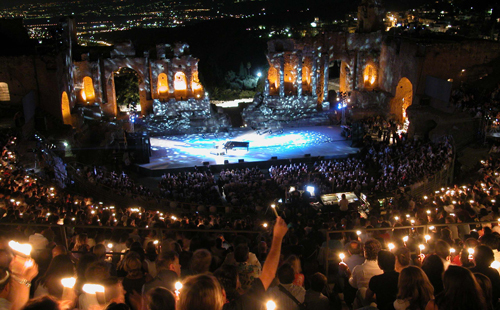
"Carnival of Acireale":
It is the most beautiful Sicilian Carnival from February 17th to March 5th. Allegorical carts, parades of masked groups and shows. A theater of wonders, there are masks, confetti, lights, flowers, music. In the seventeenth century in Sicily there is the appearance of a mask with well-defined characteristics: 'l'Abbatazzu,' also called 'Pueta Minutizzu.' The person mimed nobles or ecclesiastics, carrying a large book, from which he pretended to read, pronouncing satirical and teasing jokes. There are other masks like "the Baruni" with the intention of making fun of the aristocracy: in fact the mask was built from a costume resembling a noble but clearly mocking dress. Another mask was "i Manti," a costume with many frills that had the sole purpose of keeping the wearer anonymous. The stupendous streets and squares of the historical center of Acireale are the ideal frame for a show that reaches the highlight with the float parades, through which the acesi artisans express their wit and fantasy stimulating that of others. In Acireale there are two types of floats, the allegorical ones and the famous floral displays. The first, made in papier-mâché, are the only ones in the world to use lighting systems and mechanical pumps, while the latter are made entirely with flower arrangements.


"Festival of St. Agata":
The festival of Sant 'Agata, patron saint of Catania, is one of the most beautiful patronal festivals in the world. The first day is dedicated to the offer of candles. A beautiful folk custom wants the candles to be donated as high or as heavy as the person asking for protection. The fireworks as well as expressing the great joy of the faithful, take on a particular meaning, because they remind us that the patron, martyred on the embers, always watches over the fire of Etna and all the fires. On the 4th of February the streets of the city are populated by "citizens" already from the early hours of dawn. They are so devout that they wear the traditional "sack" (a votive white cloth ankle-length and tightened at the waist by a cord), a black velvet cap, white gloves and waving a handkerchief also pressed with thick folds . Three different keys, each guarded by a different person, are used to open the iron gate that protects the relics in the cathedral: one is guarded by the treasurer, the second by the master of ceremonies, the third by the prior of the cathedral chapter. When the third key removes the last delivery to the gate of the bedroom where the bust is kept, you can proceed. The feast of Saint Agatha is inseparable from the traditional parade of "candelore", huge candles covered with handcrafted decorations, gilded wood cherubs, saints and scenes of martyrdom, flowers and flags. The candles precede the fercolo in procession, because once, when there was no electric lighting, they had the function of illuminating the passage to the participants in the procession. Among the traditional sweets we find the cassateddi, or "Minni di Sant'Aita" refer to the udders that were torn from the saint during the martyrs she was subjected to, to force her to recant her faith.

"Festival of St. Bartolomeo":
Saint Bartholomew is the patron saint of Lipari and is celebrated several times a year on different dates: on February 13 for the first transfer of the Corps, on August 24, the official feast of the Saint established by the Church, on March 5 at the request of the peasants. That of August 24 in Marina Corta, is precisely the most important festival, the one in which all the islanders participate, and in which the procession of the statue of San Bartolomeo with the "vascelluzzo" (silver reliquary) takes place, both brought to shoulder by the various confraternities. The party ends with the spectacular fireworks over the sea.

"Snow Festival in Polizzi Generosa":
It is an excursion to the natural snowfield of Fossa della Principessa and follows the preparation of granita according to natural methods. According to an ancient local tradition, in fact, ice crystals are preserved until late summer, thanks to the cavities present in the territory where the temperature remains constant throughout the year. so it is possible to camp, hike and taste delicious fresh snow-based granitas. In the past, entire families or teams of snowmen went up into the mountains after each snowfall to accumulate snow inside a large natural pit or were dug by man. The accumulated snow had to be first pounded abundantly, so as to make it become very compact and facilitate the formation of ice and then covered with straw to create a sort of thermal insulation. These ice preserves were also marketed.

"Sicilian Cannolo Festival":
Three days dedicated to one of the best known Sicilian pastry specialties. All this is enhanced with a craft stand, shows, entertainment and a gastronomy stand. Cannolo is undoubtedly one of the most characteristic and representative products of the Sicilian confectionery.
The "Sagra del Cannolo" wants to be a celebratory event for this important protagonist of our tables and also a moment of conviviality and folklore.

" Works of Sicilian puppets":
The Puppet Theater is a representation of puppet theater, typical of Sicily. The puppets are the puppets of the epic-popular theater which, imported from Spain, developed in Sicily. It has puppets about one meter high, which evoke the epic knightly deeds of the Paladins of Charlemagne in the fight against the Saracens. It tells stories from the Chanson de Roland, from the liberated Jerusalem and from the furious Orlando. Religious events related to the Passion of Christ and the life of the Saints, Garibaldi's exploits and the stories of brigands. The most famous figures are: Orlando, Rinaldo, Angelica, Gano di Maganza, the Saracens, Rodomonte.

"Artichoke Festival in Cerda":
The Artickoke festival is held annually on April 25th in a whirlwind of events and festive events. During the festival, in fact, in addition to various entertainment events, there is a free tasting of artichokes, cooked in different ways, accompanied by local bread and wine. A chance to get together for the country that has dedicated a monument to this humble but precious vegetable.
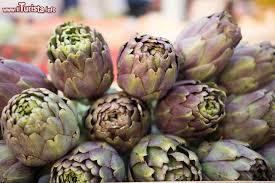
"Chocolate festival":
To further enhance this baroque territory, an event is dedicated to chocolate, an emporium able to involve buyers, consumers, craft companies for the processing of the most prestigious chocolate brands. Together they exhibit, host concerts, entertainment shows and welcome local restaurants.

"The floral display in Noto":
The Infiorata di Noto, one of the most colourful festivals anywhere in the world, takes place every year over the third weekend of May. The manifestation of the Infiorata was born in 1980 from the meeting of Genzanesi and Noto artists, and it is in the city of Genzano that this new pictorial technique is developed. Via Corrado Nicolaci is the street that frames the Infiorata and the impact is strong. The road, 122 meters long and 7 meters wide, is covered with flowers along its entire length and 6 meters in width. The rug is composed of 16 sketches. Courtyards, cloisters and city streets are adorned with squares, created with creativity and skill by the artists who offer different themes from year to year: religious, mythological, and popular culture. The floral display at Noto is considered one of the most beautiful events on the whole island. The infioratura work of the panels lasts all night and the next day the floral carpet is ready to amaze thousands of Italian and foreign visitors, until late sunset. In the evening, the start of shows and side events, cultural events of all kinds, including exhibitions, exhibitions, tastings, itineraries in the historic center and in the territory, museums and open churches.
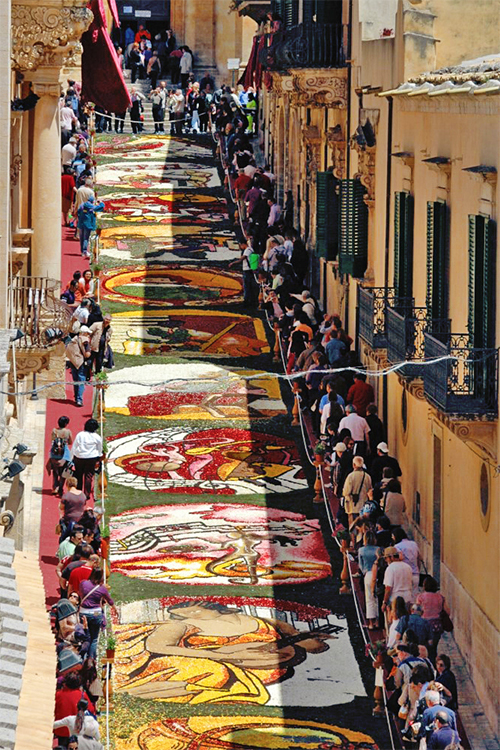
Calabria
"The night of giants":
The night of the giants is the largest event that sees 15 couples of giants from all over the region as protagonists. There are two main characters like Mata, a white woman and Grifone, a black warrior. While the couples dance, the courtship ritual is remembered. The giants turn and hug in a strong embrace always accompanied by drummers. The costumes are inherited for generations and the men are always dancing because the clothes are heavy. Infatii you dance for 20 minutes and then there is a pause to catch your breath.

"Tropea onion party":
It takes place in three days: 26,27,28 April. In this three days, the best restaurants will open their doors to serve "author tastings", international chefs will perform in show-cooking, there will be masterclasses, interviews, conferences and much more. The aim of the event is to encourage the promotion, development and socio-cultural aspect of red onion in the context of excellent regional agricultural productions.

"Chestnut festival":
This small fruit enclosed inside the hedgehog is the absolute protagonist of fairs and flea markets. It takes place in three cities: Fagnano Castello, San Donato di Ninea e Sant`Agato d`Esaro. Here you can taste the classic roasted chestnuts and taste a series of goodness based on chestnuts, including fresh pasta and desserts.

"Carnival in Castrovillari":
The Carnival of Castrovillari, in the province of Cosenza, is the most famous in Calabria, as well as one of the 10 most important Carnivals in Italy. The Castrovillari Carnival was born in 1959 as a traditional carnival with allegorical floats, parades and outdoor shows. Over the years, the Carnival grows, becoming international by welcoming folk groups from all over the world. The program continues with theater performances and musical and folk performances by groups from all over the world. A legacy that is continuously enriched with its own representations that come to life thanks to a free participation that here is history and culture as well as sensitivity and transport for the existing and its own roots.

"Chili festival in Diamante":
It was the period of the Colombiadi of Genoa when the cities celebrate all the gastronomic riches in gift from Cristoforo Colombo, but not the chili pepper. So Diamante decides to organize a festival of his own. And it is in this city, the most depicted of all with 200 murals, that everything speaks of chilli: five days of conventions, exhibitions, conceperti, cinema, satire and much more. On the banks of the river there are food stands with tastings and tastings of spicy specialties. Also many special guests as high-level international chefs, television and entertainment stars. Every year the competition and the final of the national peproncino eaters championship are held, in which the record must be broken: 500 grams of hot pepper in half an hour.

"Cleto festival":
It takes place once again along the streets of the historic center of Cleto, among the picturesque alleys and small squares, located at the foot of ancient buildings or simple poor-style buildings, creating an almost magical and surreal atmosphere. The old town of Cleto comes back to life and is repopulated with voices, music, street art, people who meet, smile (and dance). The Cleto Festival is the road we have chosen to give value to this land that can offer so much to those who decide to stay.

"The summer carnival in San Lucido":
The party begins the departure of the allegorical floats parade of Brazilian costumes, waders and much more to spend an evening in joy, in the name of the great madness and sobriety that this event succeeds in transmitting. It is organized every year for July 21st because it is associated with an ancient tradition of the place known as "a vulata". It is a custom born to remember the expulsion of the Turkish invaders in the eleventh century. At the time the Sanlucidani before throwing themselves into the sea to fight the enemies wrapped their bodies in white sheets and dyed their faces with red mulberries. Since then you have to bathe in fully dressed clothes.

"Saracena Wine Festival":
Saracen for four days will offer tastings, tasting stalls, cultural moments, street taverns, music to celebrate the Moscato di Saracena and Calabrese wines. Tastings, tasting tables, round tables, seminars, concerts are the stages of a structured journey of knowledge and sharing that also enhances the popular gastronomic culture, focusing on territorial identity. The Saracena Wine Festivaldi made is the most important and awaited moment of confrontation and meeting for regional wine producers and consortia, sector operators and the Italian specialized press.
 \
\
"Festival of St. Nicodemo":
The solemnity presents characters of popular fidelity to a tradition that is repeated in prayers and gestures that confirm the love and devotion to the Saint. Religious celebrations are intertwined with civil ones. The party also represents one of the social moments of encounter among the faithful. One of the peculiarities of the devotion to the Saint is to walk to the Sanctuary, which rises on Mount Kellerana.

Puglia
"The palio of Taranto":
The Palio of Taranto is a sports competition introduced for the first time in 1986 by entrepreneur Francesco Simonetti. It is a regatta on a rowing boat, disputed by ten crews formed by two rowers representing the ten historic city districts. The crews must travel the entire circumnavigation of the Ancient Village in less than half an hour, starting from Mar Grande and crossing Mar Piccolo to cross the finish line in the Navigable Canal. The team that gets the best score in the two stages wins the Palio.

"Tarantulas dance":
On 29 June the re-enactment of the Dance of the Tarantulas is carried out, the ancient ritual with which they were exorcised, among dances at a frenzied pace, the so-called "tarantate" women bitten by tarantulas and "possessed" by them. In Salento it is said that once the women who were bitten by tarantulas were caught in a convulsive hysterical state that was exorcised with wild music and dancing. The ancient belief is still honored with folk events. It is said, in fact, that the unbridled dance exhausted women but also the tarantos that, consumed by fatigue, were destroyed. During the Dance of the Tarantulas the whole village of Galatina dresses up and leaves room for the taranta and pizzica dancers who perform as in a ritual made of frenetic rhythms and movements, performing traditional figures that sometimes see them rotate , sometimes take hands or braid arms. The tambourines accompany the dances.


"Sword dance":
The Feast of San Biagio and Sant'Agata in Venaus sees the spectacular participation of the Spadonari who perform the Dance of Swords. The celebratory day begins at ten o'clock but about three quarters of an hour before the four Spadonari gather at the home of the one who lives closest to the church to consume a breakfast of Vin Brulè and focaccia. When the procession returns, the Spadonari stand on four sides of the altar with the weapon pointed at the ground. Mass follows and only in the moment of the o ffertorio they kneel on the right leg and salute. Then the dance begins. The Spadonari dances are four: Punta, Quadrim, Saltoe Cuori. The musical director starts the dance by guiding the music band and the Spadonari to dance. It starts with the Punta, a dance in line with the Spadonari that always remain aligned, instead during the Quadrim they are arranged in a square. After the two dances and after the musical interlude entrusted to the band, the Jump and Hearts begins. In the Hearts the arrangement is a cross - rhombus.

"Festival of St. Nicola in Bari":
Greatness, the magnificence of the festival in his honor is proportional to this faith. Thus it is only justified the interest that the inhabitants have in their patronal feast. Fireworks are nothing but an expression of this great devotion. This is the only way in which "La Festa" can be explained to those who have never seen it, to explain the chills in seeing the Saint barely pass through the alleys of "Misericordia", or the tears on the "Bridge Old". Alone, in front of thousands of silent faithful, it dominates and protects us.
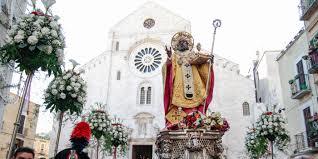
"The night of the brigands":
The Night of the brigands of Alberobello enacts the characters, the actions and the temper of brigands. This wants to offer a moment of reflection and celebration. The idea of creating a theatrical performance in the woods stems from the desire to recreate, as faithfully as possible, the atmosphere, the landscape context and the living conditions in the mid-1800s in the South. The theater show, consisting of 7 scenes.

"Calzone Festival":
This festival is born from the idea of wanting to give a new life to the feast of St. Crispin, protector of shoemakers in Acquaviva. The festival also pays homage to the red onion of Acquaviva and it is thus that a new recipe of calzone is born full of red onion, ricotta forte, eggs and goat cheese. This is how visitors in the last week of October are stuffed with trousers, sausages and barbecued meat while drinking wine. There are also live shows, music, dances, games for children, artisan, flea and antique markets.

"The festival te la uliata of Lecce":
It is a piece of bread prepared with the golden wheat of the countryside, stuffed with black olives from the olive trees of Puglia. Every family has a different recipe to prepare it so every year you can taste all types with different fillings. During the festival you can also taste the "pittule" that is fried balls of leavened dough, "the spumone salentino" that is layers of chocolate ice cream, hazelnut, vanilla on a base of sponge cake.

"The magical night of St. Giovanni":
June 24 is the magical night of St. John, an ancient tradition. The so-called summer solstice, is considered the first day of a new season and is magically combined with the feast of St. John the Baptist. An ancient popular belief tells that the sun, an element of fire, is combined with the moon, an element that recalls water. Rites of bonfires and dew, very numerous in the peasant tradition, follow one another in virtue of the meeting so awaited by the stars. The role of nature is considered magical. The night between 23 and 24 June the witches would gather around an old walnut tree. With the fruits of this tree, picked still green and fresh with dew on the night of San Giovanni, the nocino is prepared. This ritual is very much practiced in the Apulian countryside also due to the extraordinary bond between man and nature, a link that has always been recognizable in these territories.
![]()

Basilicata
"The festival, on My of Accettura":
Here we celebrate an ancient propitiatory wedding ceremony. On the day of the Ascension, loggers and woodsmen go in search of the tallest and straightest tree in the Montepiano wood, called the "May" tree. On the day of Pentecost, young people in the woods go in search of the "top", which will become the "May" bride. On days when the feast is celebrated, poetic songs of love and courtship are sung, to accompany the meeting between the two spouses. The following Tuesday, May is carried by some oxen, while the top is carried on the shoulder. It is a folkloristic festival, known for its popular character.

"The night of Cuccibocca":
The cucibocca are mysterious figures dressed in dark cloaks, old coats, a hat on their head and their faces covered with thick white beards. A broken chain is tied to the foot. The dull sound of the chain crawling on the ground announces their passage, knocking and asking for offers from door to door. In their hands they carry a basket with a lamp and a long needle with which they threaten to sew children 's mouth. So they frighten the children who will put me to bed and the Befana can bring them gifts.
They represent a unique tradition in Italy whose origin is obscure.

"The race of Sant`Antonio in Pignola":
On the evening of the 16th a large bonfire is lit, near the church of the Saint. In the past the Pignolesi brought home some embers and a bit of embers as a sign of devotion to the Saint. On the 17th the race of horses, mules and even donkeys is held and it is the culmination of a ritual to which the Pignolese are very close. The animals in the square receive the blessing and when the priest has finished the race begins. A reckless and spectacular race.

"Pollino music festival":
It take place since 1996 in the National Park of Pollino, in San Saverino Lucano. The event aims to offer spaces for concerts with great national and international artists. The festival has now become a highly anticipated event for thousands of kids from all over Italy. For many, the Pollino Music festival was an opportunity to appreciate the typical features of the Lucan area: from high altitude routes to crafts, from gastronomy to hospitality, from food products to breathtaking landscapes.
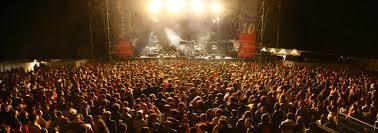
"The carnival of Satriano":
It has a very special name, "The Forest that Walks". It is a completely original event, in which people dress up as trees: these men are called Rumita (from a hermit) and are covered entirely with ivy and carry a stick with a branch of butcher's broom called frùscio on top. You can participate in the staging of a marriage with an exchange of roles, where men dress as women and women dress as men, and at the Zita party. Then the Rumìta, dressed as trees, leave the forest and arrive at the village. Going around the streets, knocking on the doors of the houses with the frùscio, a ceremony that traditionally brings good luck, and they receive gifts and food in return. The Walking Forest of the Satriano Carnival is symbolically composed of 131 wandering trees, representing the 131 countries of Basilicata.

"Bean festival":
It takes place on 18/19 August and alternates moments dedicated to the debate to other more "caserecci", in which it is possible to taste the typical local recipes during the indispensable beanola. Visitors to the festival are guided on a suggestive gastronomic journey through the characteristic alleys of the town where, in different points of the historical center, small refreshment points are set up. Among the most popular recipes there are "Trofie e Fagioli", "Potatoes mixed with beans", "Cavatelli and beans", "Lagane and beans", "Bean salad", "Rice and beans", "Beans and porcini mushrooms "," Bean soup "," Chicory and beans "," Cotechino and beans ".

"The night of St. Joseph in Basilicata":
Dozens of fires are lit on St. Joseph's night in Basilicata. In many countries of the region San Giuseppe is celebrated with parties and bonfires. Tradition has it that lighting a fire is a very ancient rite that unites Christian rites and pagan rituals. According to others, the bonfire recalls the cold that the Holy Family suffered in the cave of Bethlehem and Saint Joseph trying to light a small fire inside. The lighting of fires in the days preceding spring binds tradition to one of the most important festivals of ancient Rome, the feast of the victory of light and spring over the dark winter. Thus, with the Feast of Saint Joseph, winter is definitely greeted and the fragrance of spring begins to breathe.

"Truss festival":
The truss, is a poor dish of the peasant kitchen based in a mixture of legumes, cooked wheat and the addition of smoked bacon. It was prepared and served as a thank you for a good harvest and the hope for a better one. In fact, at the beginning of August the women prepared the truss as a symbol of life and a little generous land where men fought for survival. Even today this custom has not been lost: every year in Matera the first festival takes place, where in large pots this traditional soup linked to ancient peasant customs is prepared.
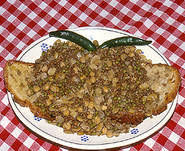
"Cod Festival":
The festival takes place every last weekend of August. The event opens with the inauguration of local handicraft exhibitions such as ceramics, wood, wrought iron, woven fabric. The cod, dried and salted cod, is a product that is easy to store and transport. This has made of the cod, cooked in many different ways, the traditional dish of Avigliano. There are so many stochastic stads, where it is possible to taste the different recipes of cod, even shows and entertainment for the public.

"The nights of magic":
The festival is enlivened by masciare, witches able to drive away the evil eye, the spirits of dead and unbaptized children but also cantastoire who tell tales, street artists musicians who give life to real acrobatic shows, juggling, ethnic music. The end is represented by the witch trial held in the square that sees the condemnation of a woman for acts of witchcraft and the burning of a puppet. Space also for all stands with typical local products.

"The festival of the Madonna del Carmine in Avigliano":
The center of the festival is the great procession. Inside the procession, besides the faithful, there is a small group of girls with loose hair, and on their heads they wear 'the belts', that is, wooden structures that hold candles decorated with flowers and ribbons and very often indicate the towers dedicated to the Madonna. The palios are also transported, wooden signs with the depiction of the face of the Madonna. The statue makes three turns around the sanctuary and then returns to the church. In the end all the faithful stop at the park for a picnic.

"The medieval days in Brindisi":
This is two days, since 1998, that this country takes a dip in the past in the Middle Ages where life takes place in castles and the minstrels animated the streets. Every autumn numerous visitors fascinated by this rush to attend. The streets become the scene of medieval markets, street shows and local food stands. They deal with re-enactments of battles, preparation of medieval camps and more. Eventually in the historic center there is a parade of people with medieval costumes starting from the castle to the village to honor the figure of the lord of the feud.

Campania
"Festival of Lilies":
The Festival of Lilies is a popular Catholic celebration that takes place every year at Nola on the occasion of the patron saint celebration dedicated to San Paolino. Paolino, in 431, returning from a long period of imprisonment at the Vandals, was welcomed by his people with large lilies, which then became a symbol of faith and love for the patron saint who became a slave to go to save in Africa the son of a widow. The flowers were later used in real wooden structures created by artisans, carpenters and carpenters. There are eight lilies plus the boat, a real symbol of the San Paolino coming by sea. The lilies are raised by 120 men. Each lily is the symbol of an art or craft and parades through the city according to a precise order: Ortolano, Salumiere, Bettoliere, Barca, Beccaio, Calzolaio, Fabbro and Sarto. The music of the lilies is particular because it maintains a constant time and has a single great purpose: to accompany the cradle of these wooden giants, the notes in fact take up the rhythm of a march.

"Festival, Madonna of the hens":
It is one of the most peculiar and characteristic folk festivals of Campania. The weekend after Easter is celebrated. It is a real riot of people, dances, songs, traditional music and colors. History is linked to a historical fact of the past. It seems that one Sunday in the 16th century some hens scratching in the chicken coop made a wooden tablet with an image of the Madonna del Carmelo emerge from under the ground. It is probable that this effigy had been buried to prevent it from being destroyed either by the iconoclasts or by the Saracens. The celebration begins with the singing of a child and a dance in a circle until the doors of the church open and the doves take flight. During the Procession the statue of the Madonna del Carmine is carried on a cart pushed by the faithful. In pagan courtyards Visitors will find tables laden with the many specialties typical of this celebration: the excellent grilled artichokes, noodles with meat sauce prepared by hand by the women of the country, and the very famous and tasty casatiello, the ancient rich dish some farmers.

"The mushroom festival":
This is the right time to taste and taste all the delicacies of mushroom dishes. This is accompanied by food stands and market stalls. The glass of wine that accompanies these delicacies is recalled. Also lots of fun for the squares with popular music.

"Nougat festival":
This country boasts of a great tradition of nougat. In 1891 it was Innocenzo Borrillo who started the production of croocante nougat based on honey, almonds and hazelnuts. A tradition that has been handed down from father to son and has come down to our days. You will not only be able to taste the specialties but you can also see the secret for the production. The event is attended by all the companies that produce the crunchy, markets, exhibitions and shows.
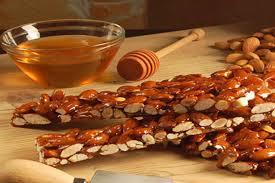
"Festival of oil lamps":
Those who take part in the party are as if they were performing an imaginary and unreal journey, through the passage of time illuminated by hundreds of small flames, once pervaded and nourished by magic and enchantment. The alleys of the Medieval Village are lit by thousands of small oil lamps arranged on wooden structures that have a typical geometric shape for each alley: circles, squares, rhombuses, triangles; a mirror placed at the bottom of the alley extends the tunnel of lights. Scenes of typical peasant banquets are set up in front of each alleyway, in which real people and other puppets take part in some cases.
Molise
"The wheat festival":
The wheat symbolizes the joy of the harvest and with the ears are available for the case and the streets. Characteristic and very particular is the parade of allegorical floats. Folkloristic, musical and pyrotechnic shows enliven the party. The tradition of the Feast of the Wheat of Jelsi originates from a thanksgiving rite to the patron saint who miraculously intervened during the earthquake in 1805 that shocked Molise. Sant’Anna is asked for protection from earthquakes and future ills by offering ears of corn.

"The festiva: the Carrese":
it takes place 3 May. On the eve of the eve a special song by Carrese is sung.
On the day of the race, the Carrese begins with the blessing of the wagons. The first race is reserved for the youngest, who compete with calf-drawn carts.
A second blessing of large wagons starts the actual race. The day after the winner has the honor of being able to carry a relic of the Holy Cross wood in procession.
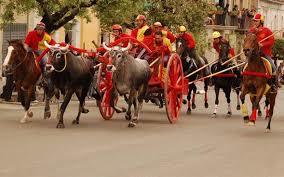
"The Maggiolata":
It is a propitiatory rite to celebrate the spring season and the awakening of nature. Early in the morning, a group of costumed boys, armed with beech branches go around the streets and enter the houses singing, to wish a good harvest.
The boys, after having performed the singing of the Maggiolata, recite in chorus "money in the pocket and ova at the basket": this is a way to ask for offers of food (above all eggs) and money. When it is time for lunch, it is the turn of the adults to go around from home to home.
With the eggs collected by the boys, the cooks of the town prepare enormous omelettes that are consumed in the square of the center of Molise, on tables set up for the occasion.
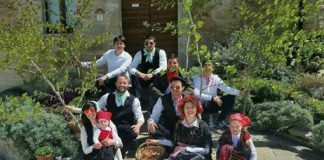
"Castle fire":
The city relives through particular representations one of the most important and at the same time tragic events in its history. The event is an explosion of lights and fireworks that ignites the sky surrounding the Castello Svevo with a spectacular luminous aura. This traditional celebration recalls the historical event of 1566, when there was an assault and the Castle was besieged and burned. It is a historical-popular representation that attracts many visitors every year. In addition to the performance there are stalls, musical shows organized on the waterfront and street food.
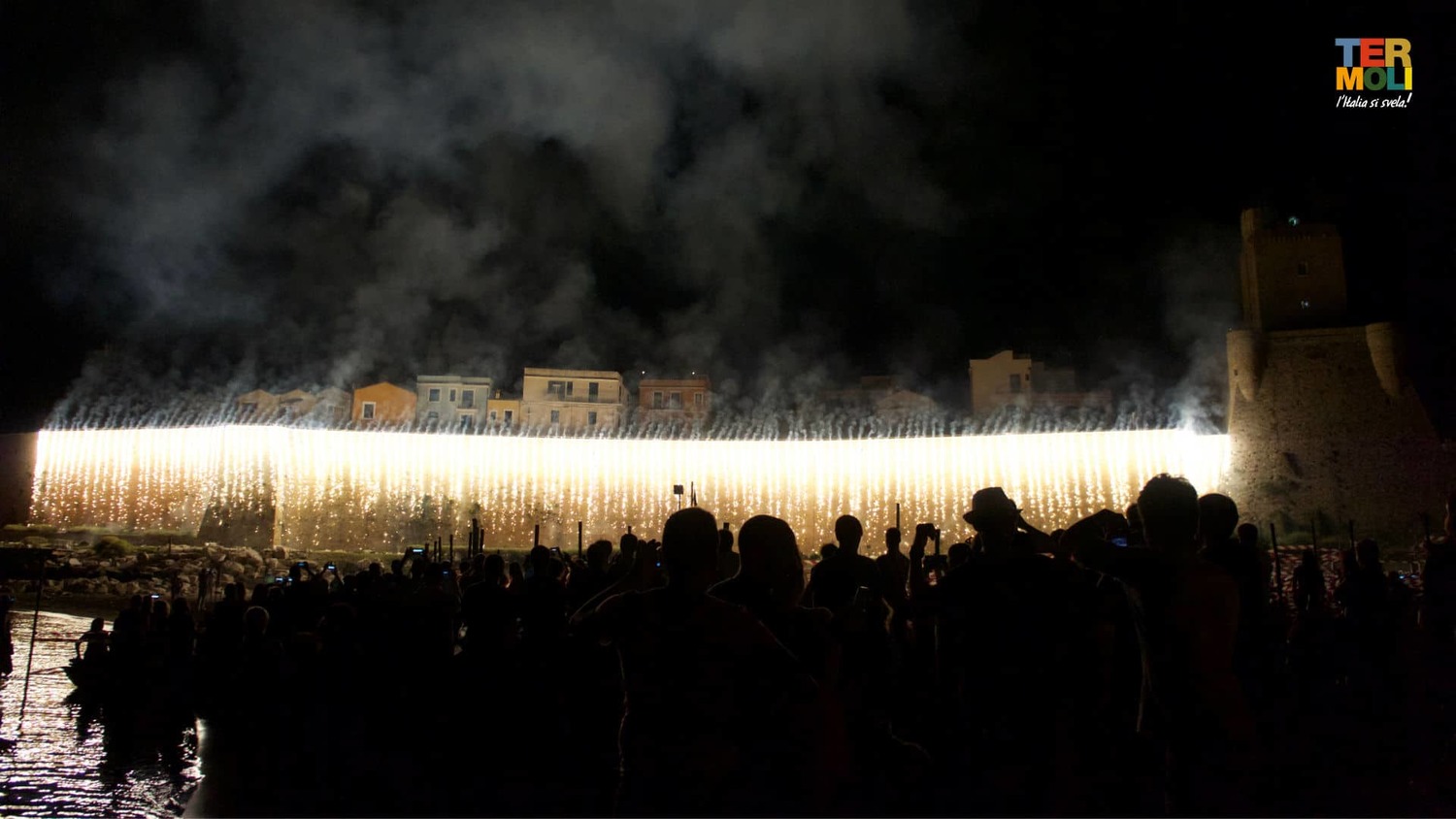
"Grape festival":
An opportunity to celebrate work in the fields and the precious fruits of the earth. In the fifties Riccia was able to resume the festivities, the feast was officially christened Sagra dell'Uva. There is a parade of floats decorated entirely with grapes and local products. Grapes and good wine you can eat and drink at will and the occasion will be perfect to also taste some typical Molise dishes, such as grilled meat, maize pizza, cavatelli with sauce.

"The Carnival of 12 months ":
In ancient times it was played by peasants, who, riding donkeys and accompanied by musicians, dressed in such shapes as to signify the various months of the year, wandered the streets of the town singing the song of the months. Another protagonist of the feast was "Francische r 'giuller", a carnival mask from Bagnoli which took on the role of the Carnival King and was sung as a song in which he declared his happiness to live and love for Pacchianella. Numerous food stands, each with a typical dish associated with a month, the presence of folkloristic groups and street artists, surround this.

"The tables of St. Joseph":
The preparation of the tables of San Giuseppe takes place in many municipalities of Molise, the families are all very busy in the preparation of the thirteen poor dishes that will become the protagonists of the table. The custom is that people who are to interpret the Holy Family are chosen, and therefore an elderly man married, a woman and a child. These are basically thirteen thin dishes, such as an appetizer of anchovies and pickles, spaghetti with breadcrumbs or tuna, rice boiled in milk, salted cod and salad, lean meatballs, lentils, peas, stuffed peppers, cauliflower or boiled broccoli, the delicious pants of St. Joseph. Lunch lasts all afternoon.
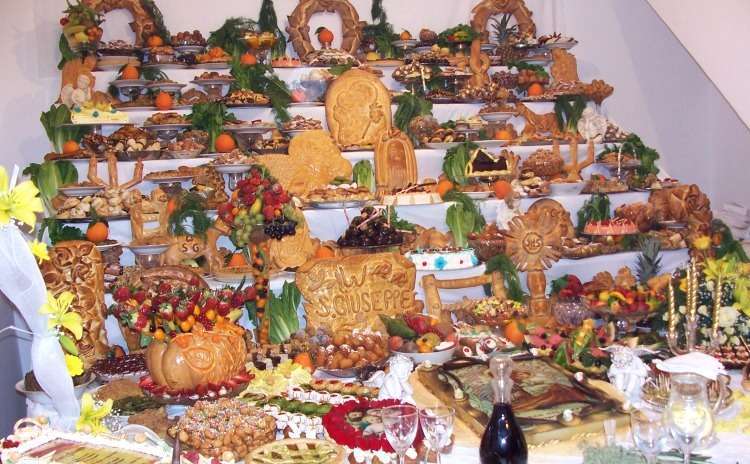
"The hooded":
The procession of Good Friday in Isernia is characterized by the presence of the "Incappucciati". The only sign of recognition is the mozzetta, or a cape that goes on the tunic, and that has a different color for each Brotherhood. The task of the hooded men is to carry on their shoulders the symbols of the Passion of the Christ. the elders of the city have the task of preparing the two plaster statues representing the Madonna Addolorata and the Cristo Morto. The statue of Christ adorned with flowers, while of the Madonna with a black dress embroidered with golden thread. On the statue of Christ the wounds are visible, while the statue of the Madonna has its heart pierced by seven swords, which represent the seven deadly sins.

"The devil's procession":
The devils are accompanied by two characters representing "death" and two monks or "squires" who keep them imprisoned with chains. The devils, whose faces are painted black, horns on their heads and wearing a heavy coat made of goat skins. The procession is preceded by two masks in white costumes with multi-colored strips of fabric and recite to the citizens the refrain "ah, death". Three masks in monastic attire holding the devil tied with heavy chains close the procession. this appointment, there are the kid and the blood sausage pizza.

Abruzzo
"The Madonna that escape":
The Madonna that Scappa is a narrative re-enactment of the encounter between the Mother of Jesus and the risen Christ. The Madonna goes out and, accompanied by the two apostles, arrives in the square, the two apostles stop, while, from a distance, the Virgin recognizes the Risen Son. gold and a red rose, while 12 doves soar in the air. The Madonna thus begins her race. If the whole sequence takes place without hindrances the tradition predicts that the year will be propitious.

"The bolt":
The party consists of a bridal parade, in the traditional dress that evokes what was once held on the occasion of the wedding, to accompany the bride and groom in their new home. . The bride wears the headdress called "cappellitto" with red laces, the "touch" of white silk and the golden "incappaturo" and adorns all the jewels. The party ends in the main square of the village, and the quadrille is dancing.

"The festival of forgiveness":
The festival of forgiveness combines religion and historical re-enactment. the historical procession of the Lady of the keys parades through the city composed of ladies, knights, notables, warriors, musicians and flag bearers in medieval and Renaissance costumes. The procession reaches the Cathedral and a lady gives the silver keys, which open the urn with the silver bust of the saint. Then the rite of the Gift of Saint Thomas takes place, in which everyone competes to offer the first fruits of the main products that are grown as a gift to the Saint.

"The night of Faugni":
All the youth of the country take part in this tradition with pride. In the main square a large bonfire is lit and everyone can attach a bundle of dried reeds from it so as to carry it through all night singing aloud. It is a propitiatory rite to thank Jesus for the products of the earth.
"The night of witches":
The story is told through the preparation of several scenes located in the medieval village and the audience staggered into groups enters the walls following a path that allows to watch all the scenes, but also to admire characteristic views of the country. The Night of the Witches is not only night, but since the morning the witches market, the tastings of typical local products, entertainment shows, accompany us until the "Night of the Witches".

"Thanksgiving":
The rural tradition is a symbol of local farmers
to thank the Lord for the success of the harvest. You can taste the typical products of the Peligna tradition in the many food and wine stands, such as spelled, polenta, stuffed yellow pizza. The festival is enlivened by the parade of floats decorated with products of the earth.

Marche
"The palio of frogs":
The race is considered one of the most particular of Italy and 7 contrade participate. Inside the wheelbarrows are positioned the frogs that are transported by the participant dressed in period costume. The winner is the one who manages to cross the finish line with the frog still on board and in his own lane. If the frog jumps out, it must resume it and continue the race. Once the race is over, the frog is returned to its natural habitat. It takes place on Friday 21st and Sunday 23rd April.

"The Challenge of the Bracelet":
The Disfida del Bracciale is perhaps the most particular historical re-enactment. The city literally plunges into an atmosphere of other times. The atisans regain possession pf the shops, the nobles return to stroll throught the streets, while the peasants pit on the clothes of the festival and enter the city to bring naskets of fruit and vegetables. Also the table is an important component of the Challenge with its rediscovery of the recipes of the time served by the taverns of the neighborhoods. Every evening the historic center is enlivened wuth the theater. Challenge day: getting ready to parade in the historical procession. Late night closes wuth the fireworks show.

"Kite festival":
The festival recalls the ten city districts that will compete in a colorful and spectacular competition that fascinates eveyone. Each districts seeks victory with the kite flying higher. Tendards and banners color Urbino.

"The palio of Castles":
It recalls the medieval celebrations of the local lords who celebrated the patron with processions and sacred offerings. The palio chooses to recall the fifteenth century, and the main event is the Tower Race, the most spectacular game because the representative of the castles compete in a race while carrying a wooden tower weighing one 100 kilos. A vintage menu is offered during the Court Dinner. Even the little ones compete in the children`s palio, tug of war, sack race, brick game.

"The festival of Calcione and ravioli":
Calcione is a speciality based on pecorino, eggs, and sugar. The external puff pastry is sweet, the heart is salty and can be fried or baked. The Treia calcione is part of the traditional food products. The ravioli is a first course that goes well with traditional sauces. Both the external pasta and the filling are salty and have the shape of the classical raviolo. During the Treia festival you can taste these two typical dishes.

"Den festival":
It always lasts two or three days. The den is a wagon that carries a construction made entirely with ears of corn. The lairs every year are different and to achieve it the commitment of the whole parish is necessary, there are those who harvest the wheat, those who interweave it, those who realize. T he art of making braidsis in the hands of women uf they are handed down from generation to generation. Ut us a patient, complex art that requires skill and is a vitue. Every evening the city is full of musical, theatrical, artistic and gastronomic events.

"Grape festival":
A great harvest festival that celebrates passion, dedication,history, the tradition of this town engaged for centuries in the cultivation of Verdicchio, lasts four days. The grape festival is fun, it`s the desire to meet, drink and dance until late. It is in the Verdicchio capital that this nectar has been produced for a long time and the harvest has been celebrated for 81 years.

Umbria
"The candle festival":
The candle festival of Gubbio, one of the most exciting and lived with greatest passion in Umbria. The Ceri are three tall and heavy wooden artefacts. The glance of the colorful crowd of Eugubini that crowds the splendid main square of Gubbio, ready to cheer for its candle. The 3 candles are then transported to the city. We thus find the race of the candles among ceraioli which is certainly one of the most crazy, characteristic and exciting historical races in Italy. It's a crazy race, but it's not a race, since you have to respect the starting order on arrival.

"The Calendimaggio":
The festival wants to revive ancient pagan customs that celebrated the return of spring and the renewal of the cycle of life, combined with the traditions of the "songs of May" performed in the Middle Ages by brigades of young people. This sees the Nobilissima Parte de Sopra and the Magnifica Parte de Sotto as protagonists. The two factions challenge each other in various skill tests, recited scenes, music and songs. During the festival, Madonna Primavera, the Queen of Calendimaggio, is also elected. Whoever leads to the end of the medieval games like wins crossbow shooting, trebling, tug of war, archery.

"The flower festival in Spello":
These are floral compositions performed by real artists, with the collaboration of the inhabitants of the village and also of the many tourists and visitors who go to Spello to admire the figurations and ornamental motifs created. The Infiorate, require a week of preparation work and are then made and completed with fresh flowers in a single night. The true artistic evolution dates back to the 1930s, when a woman drew a simple floral figure with broom and fennel on the road.

"The days of roses":
It is a market of rare and unusual plants. It is the occasion to admire a great variety of rare and unusual plants: roses, hydrangeas, aromatic plants, rare specimens of bonsai, orchids, aquatic plants, pelargoniums, secular olive trees and perennials, citrus fruits, cacti and succulent plants. Exhibitors make their knowledge available to the general public through free courses.

"Door games":
It is a historical re-enactment very much felt by the inhabitants of Umbria which consists of three days of celebration during which the village merges into a medieval atmosphere. The protagonists of the Games are the four gates that divide the city into their respective districts: Porta San Donato, Porta San Fecondino, Porta San Benedetto and Porta San Martino. The races consist of four activities, at the end of which the Palio is awarded to the winning goal: the donkey cart race; the sling shot; archery; the race with the sleeping donkey, final race and more exciting among the four, where the jockeys of the different houses challenge each other.

What to see in Umbria?
Monuments, restaurants and local foods
How to enjoy Clermont-Ferrand
Clermont-Ferrnad, located in Auvergne a green and peaceful region, is the perfect place if you want to discover France in an unusual way.
Morocco by car
Morocco by car. The full itinerary of a car trip in Morocco.
Road trip: 15 days accross Europe
Go through 4 different countries and visit new places, cultures and ways of life in a 12 days road trip accross Europe.

